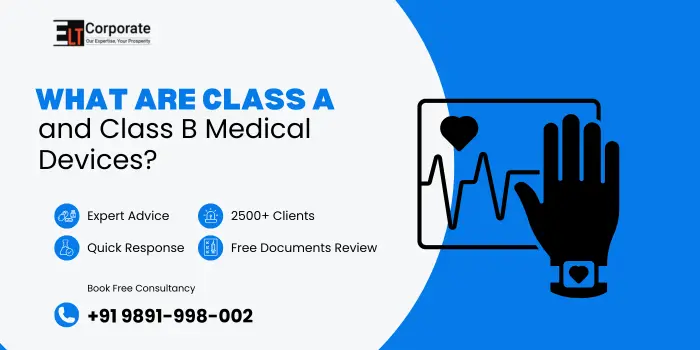In India, the Central Drugs Standard Control Organization (CDSCO) classifies medical devices into different categories based on the risk they pose to patients and users. Among these, Class A and Class B medical devices are categorized as low and low-moderate-risk devices. Understanding these classes is very important for manufacturers, importers, and distributors because the classification decides the type of license, regulatory process, and documents required.
What Are Class A Medical Devices?
Class A medical devices are low-risk devices that are simple to use and do not pose serious harm to patients. These devices are usually non-invasive.
Examples of Class A Devices:
- Thermometers
- Stethoscopes
- Surgical dressings
- Manual wheelchairs
- Tongue depressors
- These products do not require strict regulatory controls as they are relatively safe.
What Are Class B Medical Devices?
Class B medical devices are low to moderate-risk products. These are slightly more complex and may require some supervision or calibration.
Examples of Class B Devices:
- Blood pressure monitors
- Hypodermic needles
- Suction equipment
- Pregnancy test kits
- Surgical gloves
Even though they are not high-risk, Class B devices still need more regulatory documentation than Class A.
Difference Between Class A and Class B Medical Devices
| S.No. | Aspect | Class A Devices | Class B Device |
|---|---|---|---|
| 1. | Risk Levels | Low Risk | Low to Moderate Risk |
| 2. | Examples | Thermometers, Bandages | BP monitors, Syringes |
| 3. | Licenses Type | MD-5 (Manufacture) / MD-15 (Import) | MD-5 (Manufacture) / MD-15 (Import) |
| 4. | Inspection Required | Self-certification (for mfr.) | CDSCO/State inspection required |
| 5. | Notified Body Involvement | No | Yes |
| 6. | Monitoring | Minimal | Moderate |
Who Regulates Class A and Class B Devices?
In India, these devices are regulated under the Medical Device Rules, 2017 by CDSCO. For most Class A and B devices, the State Licensing Authority handles the approval, but certain imported devices require CDSCO involvement.
What Is the Process to Get a License for Class A and B Devices?
Step-by-Step Procedure for Manufacturing License (Form MD-5):
- Identify the Device Class (A or B) using CDSCO guidelines.
- Register on CDSCO’s online portal (SUGAM)
- Submit Application for MD-5 with required documents
- Pay the prescribed government fee
- Inspection by Licensing Authority (Only for Class B)
- For sterile class A devices inspection is mandatory
- License Issued upon approval
Step-by-Step Procedure for Import License (Form MD-15):
- Classify the device as per the CDSCO classification
- Create a SUGAM account
- Upload documents, including Free Sale Certificate
- Submit the MD-15 application and pay the fee
- Review by CDSCO and query resolution
- Import License issued
What Documents Are Required for Class A and B Devices?
For Manufacturing License (MD-5):
- Constitution of the firm
- Device master file
- Site master file
- ISO 13485 certificate
- Plant layout and quality system
- Undertaking and labels
For Import License (MD-15):
- Free Sale Certificate from the country of origin
- Device details
- Manufacturing license
- Test reports
- Power of Attorney
- Applicant and Importer details
Why Is Device Classification So Important for License for Class A and B Devices?
Classifying your medical device correctly is crucial because:
- It affects your regulatory pathway
- Wrong classification can lead to application rejection
- It helps avoid penalties or legal action
- Ensures patient safety
Always refer to CDSCO’s latest classification list to be sure.
How Can ELT Corporate Help You with Class A and Class B Medical Devices?
If you’re confused about the classification, licensing, or documentation for Class A and B medical devices, ELT Corporate is here to assist. Being a trusted regulatory consultancy, we offer end-to-end support for all types of medical device registrations.
- Experts in Class A and B medical device licensing
- Help with device classification and risk analysis
- Quick assistance with SUGAM portal registration
- Complete support for document preparation
- Query handling and response drafting
- Support for both domestic and imported devices
- Guidance for renewals, modifications, and audits
- Timely submission and CDSCO coordination
What is a Class A Medical Device?
A Class A medical device is a low-risk, non-invasive device like a thermometer or bandage.
What is a Class B medical Device?
Class B devices have low to moderate risk, like BP monitors or syringes.
Is Inspection Needed for Class A Devices?
No, Class A manufacturing often needs only self-certification.


Comments are closed